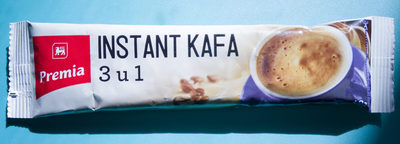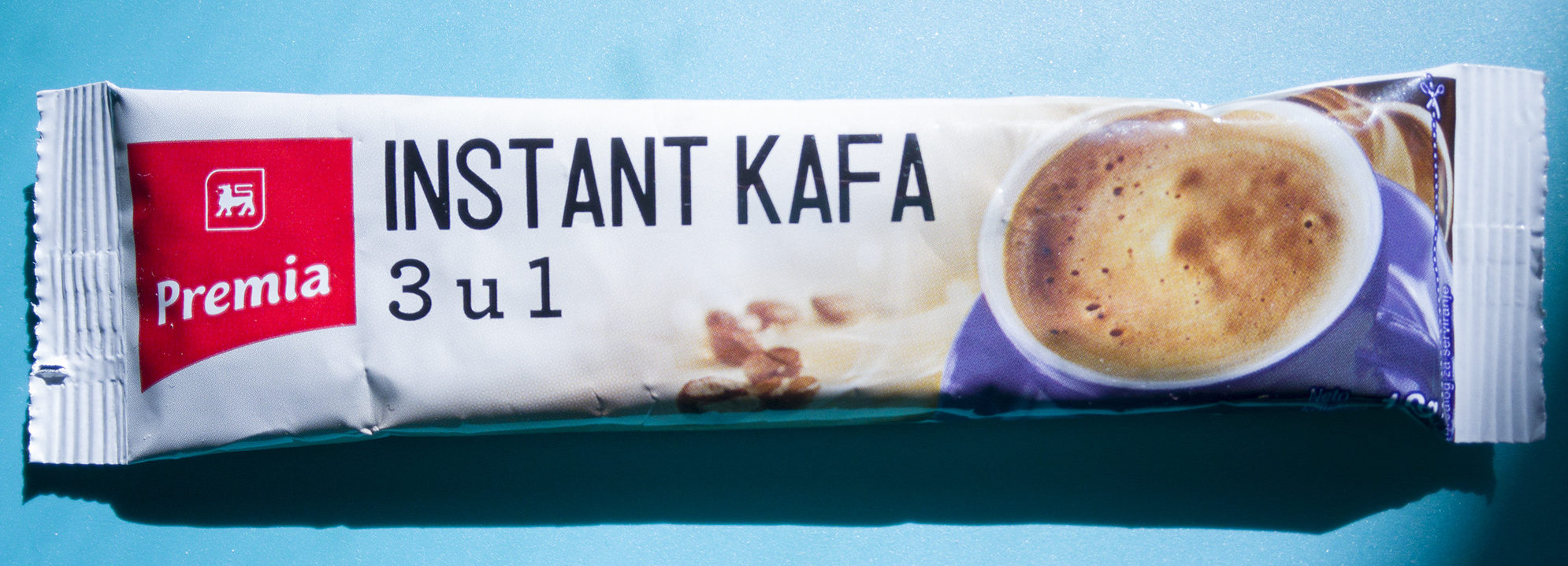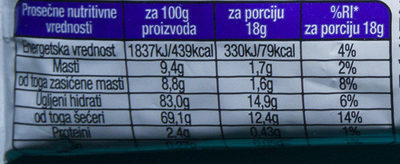Help us make food transparency the norm!
As a non-profit organization, we depend on your donations to continue informing consumers around the world about what they eat.
The food revolution starts with you!
Premia 3u1 - 18 g
Premia 3u1 - 18 g
This product page is not complete. You can help to complete it by editing it and adding more data from the photos we have, or by taking more photos using the app for Android or iPhone/iPad. Thank you!
×
Barkod: 8600197265903 (EAN / EAN-13)
Common name: Instant kafa 3u1
Količina: 18 g
Ambalaža: en:Plastic
Брендови: Premia
Категорије: en:Plant-based foods and beverages, en:Beverages, en:Plant-based foods, en:Hot beverages, en:Coffees, en:Instant beverages, en:Unsweetened beverages, en:Instant coffees
Mesto u kojem se proizvodi ili prerađuje: Serbia
Prodavnice: Maxi
Државе у којима се продаје: Србија
Matching with your preferences
Health
Sastojci
-
18 ingredients
šećer, glukozni sirup, instant kafa 9.2%, hidrogenizovana palmina biljna mast, laktoza, mlečni proteini, so, stabilizatori (E340ii, E452, E500ii), sredstvo protiv zgrudnjavanja (E551), emulgatori (E471, E472c), boja (beta karoten).Алергени: Mleko, Mlečni-proteiniTraces: Pšenica
Food processing
-
Ultra processed foods
Elements that indicate the product is in the en:4 - Ultra processed food and drink products group:
- Адитив: E452
- Адитив: E471 - Mono- i digleciridi masnih kiselina
- Адитив: E472c - Цитратни естери моно- и диглицерида масних киселина
- Адитив: E551 - Силицијум диоксид
- Ingredient: Boja
- Ingredient: Глукоза
- Ingredient: Glukozni sirup
- Ingredient: Mliječni proteini
Food products are classified into 4 groups according to their degree of processing:
- Neprerađena ili minimalno prerađena hrana
- Prerađeni kulinarski sastojci
- Prerađena hrana
- Ultra processed foods
The determination of the group is based on the category of the product and on the ingredients it contains.
Адитиви
-
E340
Potassium phosphate: Potassium phosphate is a generic term for the salts of potassium and phosphate ions including: Monopotassium phosphate -KH2PO4- -Molar mass approx: 136 g/mol- Dipotassium phosphate -K2HPO4- -Molar mass approx: 174 g/mol- Tripotassium phosphate -K3PO4- -Molar mass approx: 212.27 g/mol-As food additives, potassium phosphates have the E number E340.Source: Wikipedia (Енглески језик)
-
E340ii
Potassium phosphate: Potassium phosphate is a generic term for the salts of potassium and phosphate ions including: Monopotassium phosphate -KH2PO4- -Molar mass approx: 136 g/mol- Dipotassium phosphate -K2HPO4- -Molar mass approx: 174 g/mol- Tripotassium phosphate -K3PO4- -Molar mass approx: 212.27 g/mol-As food additives, potassium phosphates have the E number E340.Source: Wikipedia (Енглески језик)
-
E471 - Mono- i digleciridi masnih kiselina
Mono- and diglycerides of fatty acids: Mono- and diglycerides of fatty acids -E471- refers to a food additive composed of diglycerides and monoglycerides which is used as an emulsifier. This mixture is also sometimes referred to as partial glycerides.Source: Wikipedia (Енглески језик)
-
E500
Sodium carbonate: Sodium carbonate, Na2CO3, -also known as washing soda, soda ash and soda crystals, and in the monohydrate form as crystal carbonate- is the water-soluble sodium salt of carbonic acid. It most commonly occurs as a crystalline decahydrate, which readily effloresces to form a white powder, the monohydrate. Pure sodium carbonate is a white, odorless powder that is hygroscopic -absorbs moisture from the air-. It has a strongly alkaline taste, and forms a moderately basic solution in water. Sodium carbonate is well known domestically for its everyday use as a water softener. Historically it was extracted from the ashes of plants growing in sodium-rich soils, such as vegetation from the Middle East, kelp from Scotland and seaweed from Spain. Because the ashes of these sodium-rich plants were noticeably different from ashes of timber -used to create potash-, they became known as "soda ash". It is synthetically produced in large quantities from salt -sodium chloride- and limestone by a method known as the Solvay process. The manufacture of glass is one of the most important uses of sodium carbonate. Sodium carbonate acts as a flux for silica, lowering the melting point of the mixture to something achievable without special materials. This "soda glass" is mildly water-soluble, so some calcium carbonate is added to the melt mixture to make the glass produced insoluble. This type of glass is known as soda lime glass: "soda" for the sodium carbonate and "lime" for the calcium carbonate. Soda lime glass has been the most common form of glass for centuries. Sodium carbonate is also used as a relatively strong base in various settings. For example, it is used as a pH regulator to maintain stable alkaline conditions necessary for the action of the majority of photographic film developing agents. It acts as an alkali because when dissolved in water, it dissociates into the weak acid: carbonic acid and the strong alkali: sodium hydroxide. This gives sodium carbonate in solution the ability to attack metals such as aluminium with the release of hydrogen gas.It is a common additive in swimming pools used to raise the pH which can be lowered by chlorine tablets and other additives which contain acids. In cooking, it is sometimes used in place of sodium hydroxide for lyeing, especially with German pretzels and lye rolls. These dishes are treated with a solution of an alkaline substance to change the pH of the surface of the food and improve browning. In taxidermy, sodium carbonate added to boiling water will remove flesh from the bones of animal carcasses for trophy mounting or educational display. In chemistry, it is often used as an electrolyte. Electrolytes are usually salt-based, and sodium carbonate acts as a very good conductor in the process of electrolysis. In addition, unlike chloride ions, which form chlorine gas, carbonate ions are not corrosive to the anodes. It is also used as a primary standard for acid-base titrations because it is solid and air-stable, making it easy to weigh accurately.Source: Wikipedia (Енглески језик)
-
E500ii - Натријум хидрогенкарбонат
Sodium carbonate: Sodium carbonate, Na2CO3, -also known as washing soda, soda ash and soda crystals, and in the monohydrate form as crystal carbonate- is the water-soluble sodium salt of carbonic acid. It most commonly occurs as a crystalline decahydrate, which readily effloresces to form a white powder, the monohydrate. Pure sodium carbonate is a white, odorless powder that is hygroscopic -absorbs moisture from the air-. It has a strongly alkaline taste, and forms a moderately basic solution in water. Sodium carbonate is well known domestically for its everyday use as a water softener. Historically it was extracted from the ashes of plants growing in sodium-rich soils, such as vegetation from the Middle East, kelp from Scotland and seaweed from Spain. Because the ashes of these sodium-rich plants were noticeably different from ashes of timber -used to create potash-, they became known as "soda ash". It is synthetically produced in large quantities from salt -sodium chloride- and limestone by a method known as the Solvay process. The manufacture of glass is one of the most important uses of sodium carbonate. Sodium carbonate acts as a flux for silica, lowering the melting point of the mixture to something achievable without special materials. This "soda glass" is mildly water-soluble, so some calcium carbonate is added to the melt mixture to make the glass produced insoluble. This type of glass is known as soda lime glass: "soda" for the sodium carbonate and "lime" for the calcium carbonate. Soda lime glass has been the most common form of glass for centuries. Sodium carbonate is also used as a relatively strong base in various settings. For example, it is used as a pH regulator to maintain stable alkaline conditions necessary for the action of the majority of photographic film developing agents. It acts as an alkali because when dissolved in water, it dissociates into the weak acid: carbonic acid and the strong alkali: sodium hydroxide. This gives sodium carbonate in solution the ability to attack metals such as aluminium with the release of hydrogen gas.It is a common additive in swimming pools used to raise the pH which can be lowered by chlorine tablets and other additives which contain acids. In cooking, it is sometimes used in place of sodium hydroxide for lyeing, especially with German pretzels and lye rolls. These dishes are treated with a solution of an alkaline substance to change the pH of the surface of the food and improve browning. In taxidermy, sodium carbonate added to boiling water will remove flesh from the bones of animal carcasses for trophy mounting or educational display. In chemistry, it is often used as an electrolyte. Electrolytes are usually salt-based, and sodium carbonate acts as a very good conductor in the process of electrolysis. In addition, unlike chloride ions, which form chlorine gas, carbonate ions are not corrosive to the anodes. It is also used as a primary standard for acid-base titrations because it is solid and air-stable, making it easy to weigh accurately.Source: Wikipedia (Енглески језик)
-
E551 - Силицијум диоксид
Silicon dioxide: Silicon dioxide, also known as silica, silicic acid or silicic acid anydride is an oxide of silicon with the chemical formula SiO2, most commonly found in nature as quartz and in various living organisms. In many parts of the world, silica is the major constituent of sand. Silica is one of the most complex and most abundant families of materials, existing as a compound of several minerals and as synthetic product. Notable examples include fused quartz, fumed silica, silica gel, and aerogels. It is used in structural materials, microelectronics -as an electrical insulator-, and as components in the food and pharmaceutical industries. Inhaling finely divided crystalline silica is toxic and can lead to severe inflammation of the lung tissue, silicosis, bronchitis, lung cancer, and systemic autoimmune diseases, such as lupus and rheumatoid arthritis. Uptake of amorphous silicon dioxide, in high doses, leads to non-permanent short-term inflammation, where all effects heal.Source: Wikipedia (Енглески језик)
Ingredients analysis
-
Може садржати палмово уље
Ingredients that may contain palm oil: E471, E472c
-
Није веганско
Non-vegan ingredients: Mliječni proteiniSome ingredients could not be recognized.
We need your help!
You can help us recognize more ingredients and better analyze the list of ingredients for this product and others:
- Edit this product page to correct spelling mistakes in the ingredients list, and/or to remove ingredients in other languages and sentences that are not related to the ingredients.
- Add new entries, synonyms or translations to our multilingual lists of ingredients, ingredient processing methods, and labels.
If you would like to help, join the #ingredients channel on our Slack discussion space and/or learn about ingredients analysis on our wiki. Thank you!
-
en:Vegetarian status unknown
Unrecognized ingredients: Instant-kafa, Hidrogenizovana-palmina-biljna-mast, Laktoza, Stabilizatori, Sredstvo-protiv-zgrudnjavanja, Emulgatori, Beta-karotenSome ingredients could not be recognized.
We need your help!
You can help us recognize more ingredients and better analyze the list of ingredients for this product and others:
- Edit this product page to correct spelling mistakes in the ingredients list, and/or to remove ingredients in other languages and sentences that are not related to the ingredients.
- Add new entries, synonyms or translations to our multilingual lists of ingredients, ingredient processing methods, and labels.
If you would like to help, join the #ingredients channel on our Slack discussion space and/or learn about ingredients analysis on our wiki. Thank you!
-
Details of the analysis of the ingredients
We need your help!
Some ingredients could not be recognized.
We need your help!
You can help us recognize more ingredients and better analyze the list of ingredients for this product and others:
- Edit this product page to correct spelling mistakes in the ingredients list, and/or to remove ingredients in other languages and sentences that are not related to the ingredients.
- Add new entries, synonyms or translations to our multilingual lists of ingredients, ingredient processing methods, and labels.
If you would like to help, join the #ingredients channel on our Slack discussion space and/or learn about ingredients analysis on our wiki. Thank you!
: šećer, glukozni sirup, instant kafa 9.2%, hidrogenizovana palmina biljna mast, _laktoza_, _mlečni proteini_, so, stabilizatori (e340ii, e452, e500ii), sredstvo protiv zgrudnjavanja (e551), emulgatori (e471, e472c), boja (beta karoten)- šećer -> en:sugar - vegan: yes - vegetarian: yes - ciqual_proxy_food_code: 31016 - percent_min: 16.45 - percent_max: 81.6
- glukozni sirup -> en:glucose-syrup - vegan: yes - vegetarian: yes - ciqual_proxy_food_code: 31016 - percent_min: 9.2 - percent_max: 45.4
- instant kafa -> sr:instant-kafa - percent_min: 9.2 - percent: 9.2 - percent_max: 9.2
- hidrogenizovana palmina biljna mast -> sr:hidrogenizovana-palmina-biljna-mast - percent_min: 0 - percent_max: 9.2
- _laktoza_ -> sr:laktoza - percent_min: 0 - percent_max: 9.2
- _mlečni proteini_ -> en:milk-proteins - vegan: no - vegetarian: yes - percent_min: 0 - percent_max: 9.2
- so -> en:salt - vegan: yes - vegetarian: yes - ciqual_food_code: 11058 - percent_min: 0 - percent_max: 0.27
- stabilizatori -> sr:stabilizatori - percent_min: 0 - percent_max: 0.27
- e340ii -> en:e340ii - vegan: yes - vegetarian: yes - percent_min: 0 - percent_max: 0.27
- e452 -> en:e452 - vegan: yes - vegetarian: yes - percent_min: 0 - percent_max: 0.135
- e500ii -> en:e500ii - vegan: yes - vegetarian: yes - percent_min: 0 - percent_max: 0.09
- sredstvo protiv zgrudnjavanja -> sr:sredstvo-protiv-zgrudnjavanja - percent_min: 0 - percent_max: 0.27
- e551 -> en:e551 - vegan: yes - vegetarian: yes - percent_min: 0 - percent_max: 0.27
- emulgatori -> sr:emulgatori - percent_min: 0 - percent_max: 0.27
- e471 -> en:e471 - vegan: maybe - vegetarian: maybe - from_palm_oil: maybe - percent_min: 0 - percent_max: 0.27
- e472c -> en:e472c - vegan: maybe - vegetarian: maybe - from_palm_oil: maybe - percent_min: 0 - percent_max: 0.135
- boja -> en:colour - percent_min: 0 - percent_max: 0.27
- beta karoten -> sr:beta-karoten - percent_min: 0 - percent_max: 0.27
Nutritivne vrednosti
-
Hranljiva vrednost
Hranljiva vrednost As sold
for 100 g / 100 mlAs sold
per serving (18 g)Compared to: en:Instant coffees Енергија 1.837 kj
(439 kcal)331 kj
(79 kcal)+13% Масти 9,4 g 1,69 g +12% Zasićena mast 8,8 g 1,58 g +15% Carbohydrates 83 g 14,9 g +18% Шећер 69,1 g 12,4 g +52% Fiber ? ? Протеин 2,4 g 0,432 g -18% Со 0,27 g 0,049 g -56% Fruits‚ vegetables‚ nuts and rapeseed‚ walnut and olive oils (estimate from ingredients list analysis) 0 % 0 %
Environment
-
Eco-Score E - Very high environmental impact
The Eco-Score is an experimental score that summarizes the environmental impacts of food products.→ The Eco-Score was initially developped for France and it is being extended to other European countries. The Eco-Score formula is subject to change as it is regularly improved to make it more precise and better suited to each country.Life cycle analysis
-
Average impact of products of the same category: E (Score: 0/100)
Категорија: Coffee, powder, instant, non rehydrated
Категорија: Coffee, powder, instant, non rehydrated
- PEF environmental score: 4.36 (the lower the score, the lower the impact)
- including impact on climate change: 27.07 kg CO2 eq/kg of product
Stage Impact Agriculture
84.0 %Processing
14.4 %Ambalaža
0.2 %Transportation
1.3 %Distribution
0.1 %Consumption
0.0 %
Bonuses and maluses
-
Missing origins of ingredients information
Malus: -5
⚠ ️ The origins of the ingredients of this product are not indicated.
If they are indicated on the packaging, you can modify the product sheet and add them.
If you are the manufacturer of this product, you can send us the information with our free platform for producers.
-
Packaging with a medium impact
Malus: -10
Shape Material Recycling Impact Unknown Plastic Високо ⚠ ️ The information about the packaging of this product is not sufficiently precise (exact shapes and materials of all components of the packaging).⚠ ️ For a more precise calculation of the Eco-Score, you can modify the product page and add them.
If you are the manufacturer of this product, you can send us the information with our free platform for producers.
Eco-Score for this product
-
Impact for this product: E (Score: -15/100)
Производ: Premia 3u1 - 18 g
Life cycle analysis score: 0
Sum of bonuses and maluses: -15
Final score: -15/100
-
Carbon footprint
-
Equal to driving 14.0 km in a petrol car
2707 g CO² per 100g of product
The carbon emission figure comes from ADEME's Agribalyse database, for the category: Coffee, powder, instant, non rehydrated (Source: ADEME Agribalyse Database)
Stage Impact Agriculture
72.0 %Processing
25.9 %Ambalaža
0.4 %Transportation
1.7 %Distribution
0.1 %Consumption
0.0 %
Ambalaža
-
Packaging with a medium impact
-
Packaging parts
(Plastic)
-
Packaging materials
Material % Packaging weight Packaging weight per 100 g of product Plastic
-
Transportation
-
Origins of ingredients
Missing origins of ingredients information
⚠ ️ The origins of the ingredients of this product are not indicated.
If they are indicated on the packaging, you can modify the product sheet and add them.
If you are the manufacturer of this product, you can send us the information with our free platform for producers.Add the origins of ingredients for this product Add the origins of ingredients for this product
Report a problem
-
Incomplete or incorrect information?
Category, labels, ingredients, allergens, nutritional information, photos etc.
If the information does not match the information on the packaging, please complete or correct it. Open Food Facts is a collaborative database, and every contribution is useful for all.
Data sources
Product added on од bojackhorseman
Last edit of product page on од packbot.








